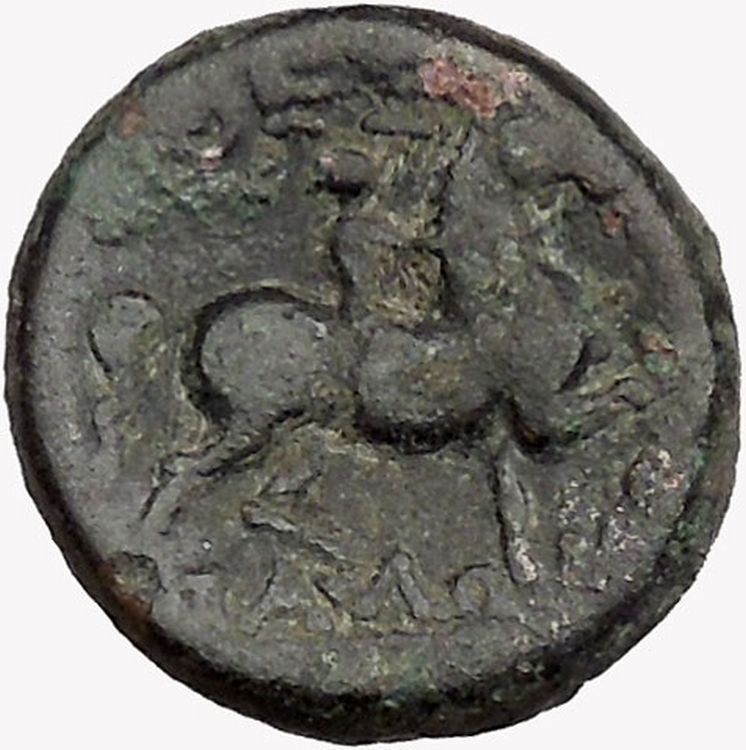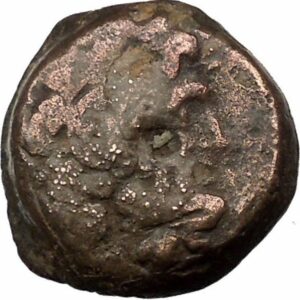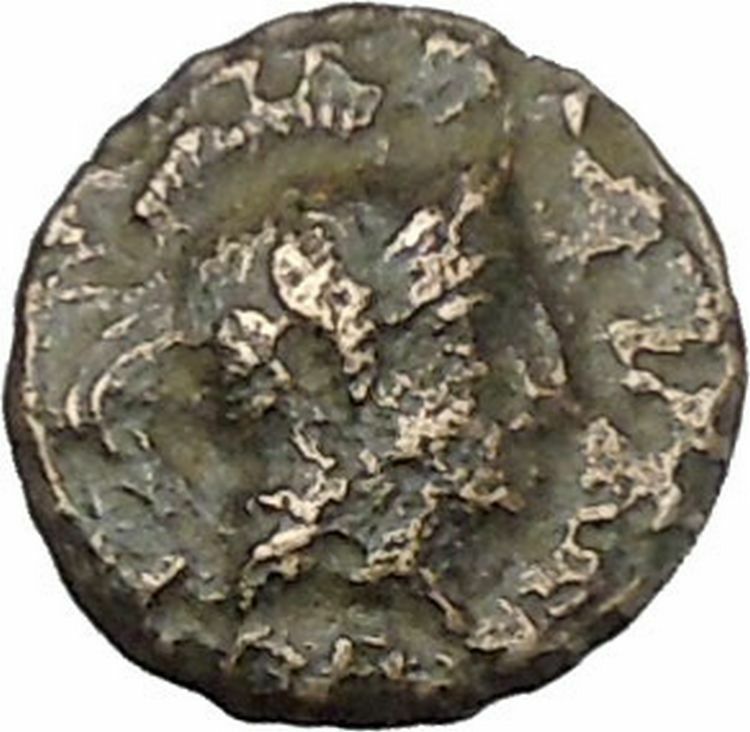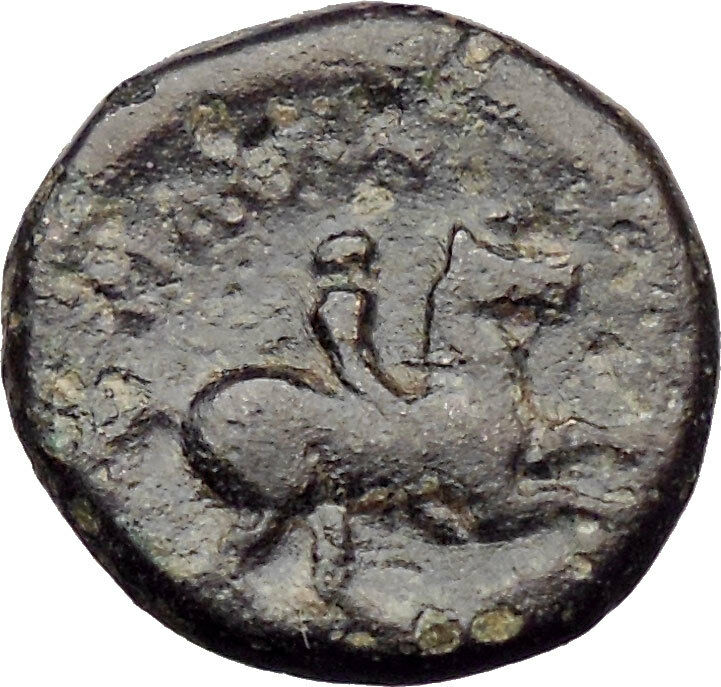|
Greek city of Lampsakos in Mysia
Bronze 11mm (1.70 grams) Struck circa 400-200 B.C.
Reference: SNG France 1223-6
Female head right, hair bound in chignon.
Forepart of Pegasus right.
You are bidding on the exact item pictured,
provided with a Certificate of Authenticity and Lifetime Guarantee of
Authenticity.
|
Pegasus |

Bellerophon riding Pegasus (1914) |
| Sky |
| Parents |
Poseidon
and Medusa |
| Siblings |
Chrysaor
|
| Mount |
Mt. Olympus
|
Pegasus (Ancient
Greek: Πήγασος, Pégasos,
Latin Pegasus) is one of the
best known mythological creatures in Greek
mythology. He is a winged divine stallion usually depicted as pure
white in colour. He was sired by Poseidon,
in his role as horse-god, and foaled by the Gorgon Medusa. He
was the brother of Chrysaor,
born at a single birthing when his mother was decapitated by Perseus.
Greco-Roman poets write about his ascent to heaven after his birth and his
obeisance toZeus,
king of the gods, who instructed him to bring lightning and thunder from
Olympus. Friend of the Muses, Pegasus is the creator of Hippocrene,
the fountain on Mt.
Helicon. He was captured by the Greek hero Bellerophon near
the fountain Peirene with the help of Athena and Poseidon. Pegasus allows the
hero to ride him to defeat a monster, the Chimera, before realizing many other
exploits. His rider, however, falls off his back trying to reach Mount Olympus.
Zeus transformed him into the constellation Pegasus and
placed him up in the sky.
Hypotheses have been proposed regarding its relationship with the Muses,
the gods Athena, Poseidon, Zeus, Apollo,
and the hero Perseus.
The symbolism of Pegasus varies with time. Symbol of wisdom and especially of
fame from the Middle Ages until the Renaissance, he became one symbol of the
poetry and the creator of sources in which the poets come to draw inspiration,
particularly in the 19th century. Pegasus is the subject of a very rich
iconography, especially through the ancient Greek pottery and paintings and
sculptures of the Renaissance. Personification of the water, solar myth, or
shaman mount, Carl Jung and his followers have seen in Pegasus a profound
symbolic esoteric in relation to the spiritual energy that allows to access to
the realm of the gods on Mount Olympus.
In the 20th and 21st century, he appeared in movies, in fantasy, in video games
and in role play, where by extension, the term “pegasus” (plural: “pegasi”) is
often used to refer to any winged horse.
Etymology

Pegasus, as the horse of Muses, was put on the roof of Poznań
Opera House(Max
Littmann, 1910)
The poet Hesiod presents
a folk
etymology if the name Pegasus as
derived from pēgē “spring,
well”: “the pegai of Okeanos,
where he was born.”
A proposed etymology of the name is Luwian pihassas,
meaning “lightning”, and Pihassassi,
a local Luwian-Hittite name in southern Cilicia of a weather god represented
with thunder and lightning. The proponents of this etymology adduce Pegasus’
role, reported as early as Hesiod,
as bringer of thunderbolts to Zeus. It was first suggested in 1952 and remains
widely accepted, but Robin
Lane Fox (2009) has criticized it as implausible.
Pegasus and springs
According to legend, everywhere the winged horse struck his hoof to the earth,
an inspiring spring burst forth. One of these springs was upon the Muses‘ Mount
Helicon, the Hippocrene (“horse
spring”), opened, Antoninus
Liberalis suggested, at
the behest of Poseidon to
prevent the mountain swelling
with rapture at the song of the Muses; another was at Troezen. Hesiod
relates how Pegasus was peacefully drinking from a spring when the hero Bellerophon captured
him. Hesiod also says Pegasus carried thunderbolts for Zeus.
Birth
There are several versions of the birth of the winged stallion and his brother Chrysaor in
the far distant place at the edge of Earth, Hesiod’s “springs of Oceanus, which
encircles the inhabited earth, where Perseus found Medusa:
One is that they sprang from the blood issuing from Medusa’s neck as Perseus was
beheading her, similar to the manner
in which Athena was
born from the head of Zeus. In another version, when Perseus beheaded Medusa,
they were born of the Earth, fed by the Gorgon’s blood. A variation of this
story holds that they were formed from the mingling of Medusa’s blood, Pain and
sea foam, implying that Poseidon had involvement in their making. The last
version bears resemblance to the birth of Aphrodite,
daughter of Zeus.
Pedigree of
Pegasus
Sire
Poseidon
|
Cronus
|
Uranus
|
Gaïa or Nyx |
Gaïa or
Nyx |
|
Gaïa
|
Chaos
|
| Chaos |
|
Rhea
|
Uranus |
Gaïa or
Nyx |
Gaïa or
Nyx |
|
Gaïa |
Chaos |
| Chaos |
Dam
Medusa
|
Phorcys
|
Pontus
|
Ether
or
Uranus |
| Gaïa |
|
Gaïa |
Chaos |
| Chaos |
|
Ceto
|
Pontus |
Ether
or Uranus |
| Gaïa |
|
Gaïa |
Chaos |
| Chaos |
Bellerophon
Pegasus aided the hero Bellerophon in
his fight against both the Chimera and
the Amazons.
There are varying tales as to how Bellerophon found Pegasus; the most common says
that the hero was told by Polyeidos to
sleep in the temple
of Athena, where the goddess visited him in the night and presented
him with a golden bridle. The next morning, still clutching the bridle, he found
Pegasus drinking at the Pierian spring
and caught Pegasus, and eventually tamed him.
Perseus
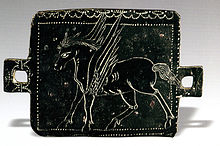
Parthian
era
bronze plate depicting Pegasus (“Pegaz” in Persian), excavated inMasjed
Soleyman, Khūzestān, Iran.
Michaud’s Biographie universelle relates
that when Pegasus was born, he flew to where thunder and lightning is released.
Then, according to certain versions of the myth, Athena tamed him and gave him
to Perseus, who flew to Ethiopia to help Andromeda.
In fact Pegasus is a late addition to the story of Perseus, who flew on his own
with the sandals loaned him by Hermes.
Olympus
Pegasus and Athena left Bellerophon to forge some sweet goods and continued to
Olympus where he was stabled with Zeus‘
other steeds, and was given the task of carrying Zeus‘
thunderbolts. Because of his faithful service to Zeus, he was honored with
transformation into aconstellation. On
the day of his catasterism,
when Zeus transformed him into a constellation, a single feather fell to the
earth near the city of Tarsus.
Legacy
World War II

The emblem of the World War II, British Airborne Forces, Bellerophon riding
the flying horse Pegasus.
During World
War II, the silhouetted image of Bellerophon the warrior, mounted on
the winged Pegasus, was adopted by the United
Kingdom‘s newly-raised parachute troops in 1941 as their upper sleeve
insignia. The image clearly symbolized a warrior arriving at a battle by air,
the same tactics used by paratroopers.
The square upper-sleeve insignia comprised Bellerophon/Pegasus in light blue on
a maroon background. The insignia was designed by famous English novelist Daphne
du Maurier, who was married to the commander of the 1st
Airborne Division (and
later the expanded British Airborne Forces), General Frederick
“Boy” Browning. According
to The British Army Website, the insignia was designed by Major Edward Seago in
May, 1942. The maroon background on the insignia was later used again by the
Airborne Forces when they adopted the famous maroon beret in Summer 1942. The
beret was the origin of the German nickname for British airborne troops, The Red
Devils. Today’s Parachute
Regiment carries on the
maroon beret tradition.
During the airborne
phase of the Normandy
invasion on the night of
5–6 June 1944, British
6th Airborne Division captured
all its key objectives in advance of the seaborne assault, including the capture
and holding at all costs of a vital bridge over theCaen
Canal, near Ouistreham.
In memory of their tenacity, the bridge has been known ever since as Pegasus
Bridge.
Popular culture
Main article: Pegasus
in popular culture
The winged horse that has provided an instantly recognizable corporate logo or
emblem of inspiration. Pegasus in Yu-Gi-Oh! is
a evil man who wants to steal the Exodyssian pecies. The South American country
of Ecuador launched
its first a satellite, named “Pegaso” (Pegaus in Spanish) on April 26, 2013. Pegasus
Seiya, the central character in the anime series Saint
Seiya , (Knights of the
Zodiac) takes his name “Pegasus” from the Pegasus Bronze Cloth he uses to
produce his armor. Pegasus
Airlines (Turkish: Pegasus
Hava Taşımacılığı A.Ş.) is a low-cost airline headquartered in the Kurtköy area
of Pendik, Istanbul, Turkey.
Lampsacus (Greek:
Λάμψακος, Lampsakos, modern:Lapseki)
was an ancient Greek
city strategically located on the eastern side of the
Hellespont
in the northern Troad
.
An inhabitant of Lampsacus was called a Lampsacene. The name has been
transmitted in the nearby modern town of
Lapseki
.
//
History
Originally known as Pityusa or Pityussa
(Greek:
Πιτυουσα, Pituousa, or Πιτυουσσα,
Pituoussa), it was colonized from
Phocaea
and
Miletus
.
During the
6th
and 5th century BC
, Lampsacus was successively dominated by
Lydia
,
Persia
, Athens
,
and Sparta
;
Artaxerxes I
assigned it to
Themistocles
with the expectation that the city supply the Persian king with
its famous wine
.
Lampsacus joined the
Delian League
after the
battle of Mycale
, and paid a tribute of twelve
talents
, a testimony to its wealth, and it had a
gold coinage in the
4th
century BC
, an activity only available to the more prosperous cities.
A revolt against the Athenians in
411 BC
was put
down by force. In 196 BC
, the
Romans
defended the town against
Antiochus the Great
, and it became an ally of Rome;
Cicero
(2
Verr. i. 24. 63) and
Strabo
(13. 1.
15) attest its continuing prosperity under Roman rule. Lampsacus was also
notable for its worship of
Priapus
, who
was said to have been born there.
Lampsacus produced a series of notable philosophers.
Metrodorus of Lampsacus (the elder)
(5th century BC) was a philosopher from
the school of
Anaxagoras
.
Strato of Lampsacus
(c. 335-c. 269 BC) was a Peripatetic philosopher and the
third director of Aristotle’s
Lyceum
at
Athens.
Euaeon of Lampsacus
was one of
Plato
‘s students.
A group of Lampsacenes were in the circle of
Epicurus
;
they included
Polyaenus of Lampsacus
(c. 340 – 278 BC) a mathematician, the philosophers
Idomeneus of Lampsacus
,
Colotes
the
satirist and
Leonteus of Lampsacus
;
Batis of Lampsacus
the wife of Idomeneus, was the sister of
Metrodorus of Lampsacus (the younger)
, whose elder brother, also a friend of
Epicurus, was
Timocrates of Lampsacus
.
Christian
history
According to legend,
St Tryphon
was buried at Lampsacus after his martyrdom at
Nicaea
in 250 AD
.
The first known bishop
in Lampsacus was
Parthenius
, under
Constantine I
. In 364, the
see
was occupied by Marcian
and in the same year a council of bishops was held at Lampsacus.
Marcian, was summoned to the
First Council of Constantinople
of
Constantinople
in 381, but refused to retract his adherence of the
Macedonian
Christian
sect. Other known
Bishops of Lampsacus were
Daniel
, who assisted at the
Council of Chalcedon
(451);
Harmonius
(458); Constantine (680), who attended the
Third Council of Constantinople
; John (787), at Nicaea;
St. Euschemon
, a correspondent of
St. Theodore the Studite
, and a confessor of the Faith for the veneration of
images, under
Theophilus
.
The See of Lampsacus is mentioned in the “Notitiae
Episcopatuum” until about the twelfth or thirteenth century.
Modern
settlement
The nearby settlement of
Lapseki
has
inherited the name; its population is now in the region of 11,000.
|









